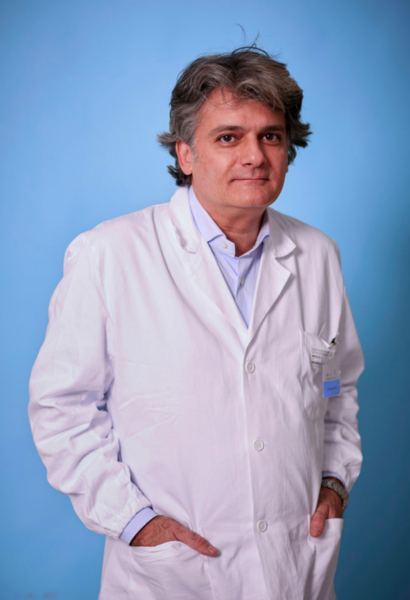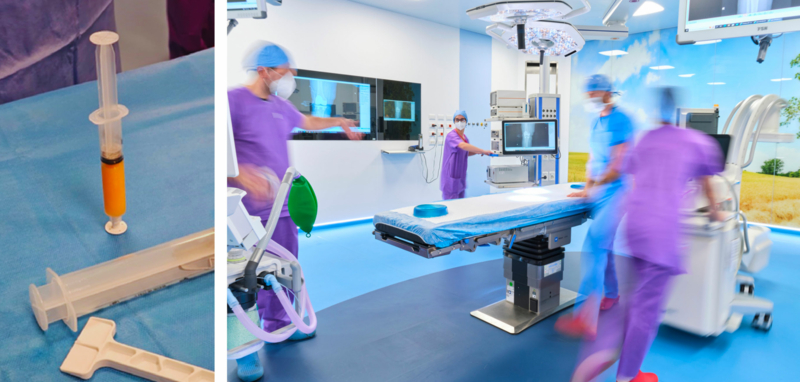Regenerative medicine represents one of the most innovative fields of biomedical research. Its development aims to offer the possibility of replacing or regenerating tissue by stimulating the body's own repair mechanisms. Regenerative medicine methods are now widely used in the orthopaedic field in the treatment of early arthrosis, ligament, tendon and meniscal injuries. However, there is growing interest in the use of the same techniques also in the treatment of arthritic spine pathology. In selected cases, people with lumbar disc herniations and significant degeneration of the interbody disc, it is possible to use these techniques and technologies. Once the herniated disc has been removed by means of a surgical microdiscectomy, adipose tissue (fat) is removed from the person by means of a mini-suction with a dedicated needle. This, thanks to special technologies, is purified and prepared in real time to then be administered into the damaged disc (figure ).
The procedure aims to reduce local inflammation and further improve the post-operative course. Future studies will be able to tell whether there has also been a limitation of disc damage or even disc regeneration. The procedure is absolutely minimally invasive, overlapping with simple microdiscectomy, with the same short hospital stay and post-operative recovery time.
 Regenerative Medicine and Spinal Surgery: Minimally Invasive Innovations in the Treatment of Disc Hernias at the Casa di Cura Santa Maria Maddalena Hospital
Regenerative Medicine and Spinal Surgery: Minimally Invasive Innovations in the Treatment of Disc Hernias at the Casa di Cura Santa Maria Maddalena Hospital
One of the most innovative areas of biomedical research today is regenerative medicine, the aim of which is to offer the possibility of replacing or regenerating tissue by stimulating the repair mechanisms inherent in the patient's own body.
Dr. Giuseppe Maida - in charge, with his collaborators Dr. Antonio Musio and Dr. Adele Pellegrini, of the Vertebral Surgery Operating Unit at the Casa Cura Santa Maria Maddalena Occhiobello (RO). ssa Adele Pellegrini, of the Vertebral Surgery Operating Unit at the Casa di Cura Santa Maria Maddalena Hospital in Occhiobello (RO) - states: Regenerative medicine methods are now widely used in the orthopaedic field - also at our hospital - in the treatment of early arthrosis and ligament, tendon and meniscal lesions; however, there is a growing interest in the use of the same techniques also in the treatment of arthritic pathologies of the spinal column.
The Vertebral Surgery Operating Unit of the Casa di Cura Santa Maria Maddalena Hospital uses these techniques in the treatment of herniated discs. Dr. Giuseppe Maida continues: "in some cases, carefully selected in reference to people suffering from lumbar disc herniation and significant degeneration of the intersomatic disc, it is possible to use the aforementioned techniques and technologies: once the herniated disc has been removed by means of surgical microdiscectomy, adipose tissue (fat) is taken from the patient by means of a mini-suction with a dedicated needle. The harvested tissue, thanks to special innovative technologies, is purified in real time and prepared for subsequent administration into the patient's disc.
This procedure aims to reduce local inflammation and further improve the post-operative course. Future studies may better indicate whether there will also be a limitation of disc damage or even full regeneration of the disc. The procedure is absolutely minimally invasive, overlapping with simple microdiscectomy and with the same short post-operative recovery and hospitalisation time.
In this regard, Dr. Vittorio Morello (General Manager and Special Prosecutor) emphasizes: "The Santa Maria Maddalena Treatment Center confirms its attention to technical and technological innovations as well as its sensitivity to the importance of scientific research, honouring its role as a reference point in the area and giving further impetus to the program offered to residents and residents in Neurosurgery at the University of Modena and Reggio Emilia who - for the past three years - have been spending a period of their training at our facility. The teamwork and collaboration between all the professional figures (Operating Unit, patient reception, Operating Room staff) is of fundamental importance to ensure a service of absolute excellence.". 
See also
Prima Rovigo
Rovigo.news
